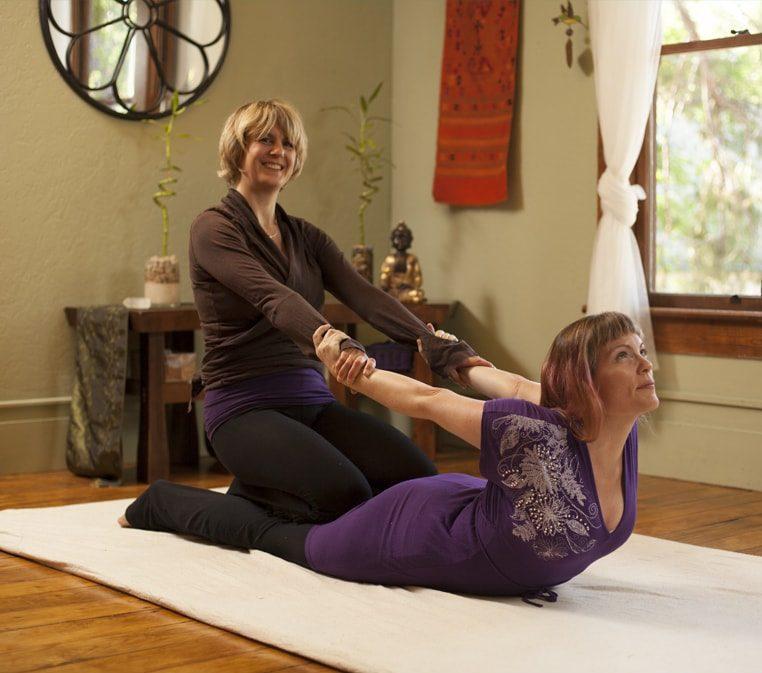
You want to read this article if you are a bodywork client or student, or thinking of becoming one. Since I use Thai Massage as my foundation piece to treat you body-wise I figured I should give you the lowdown on the history, benefits and techniques.
Here it goes:
Thai Massage is an energy based healing system that combines acupressure, reflexology and assisted yoga postures to stimulate, circulate, and unblock vital energy in the body. There are 10 main pathways of energy (Sen Lines) we use in Thai Massage. They can be related to the nadis of Ayurveda and the meridians of Chinese Medicine. The practitioner of Thai Massage uses a variety of techniques; gentle rocking, slow compression, deep assisted stretching and specific acupressure work, to address these Sen Lines. The overall goal is to achieve energy balance and harmony within the body.
Thai Massage is done on a mat on the floor with the receiver wearing loose, comfortable clothing, which allows for unrestricted movement during the session. The practitioner uses their thumbs, palms, forearms, elbows, knees and feet, which allows for a nurturing touch with deep pressure. The movement of Thai Massage is dynamic, going to, but never beyond an individual’s limit and level of comfort.
Virtually anyone can receive Thai massage in the hands of an experienced practitioner. There are so many working techniques that it is applicable for a wide variety of people including athletes, the elderly, pregnant women, men and women with therapeutic challenges. A skilled pracitioner is able to adjust according to your needs. For example, for healthy people I work more dynamically and deep, for the elderly I would choose a more static approach with lots of gentle compression of energy lines.
Thai Massage balances the major muscle groups (feet to face) and stimulates the body’s natural healing process. That’s a tremendous benefit in itself.
Therapeutically Thai Massage can be used to treat hypertension, lower back pain, sciatica, asthma, arthritis, neck and shoulder tightness, knee injuries, chronic headaches, migraines … just to name a few. Thai Massage aids in:
People often experience positive mental and psychological shifts over several days or weeks after the treatment. These may include:

Traditional Thai massage has been practiced for over 2500 years in Asia but was little known to the West until recently. The legendary founder is believed to be a doctor from northern India, known as Jivaka Kumar Bhaccha, or Dr. Shivago. He was a contemporary of the Buddha and personal physician to King Bimbisara over 2,500 years ago. In other words, Thai Massage is not new-agey but has a long ass history to look back upon.
The theoretical foundation of Thai massage is based on the concept of invisible energy lines running through the body. The Indian origin and influence is obvious since the background of this theory clearly lies in Yoga philosophy. Yoga philosophy states that life energy, or Prana, is absorbed with the air we breathe and with the food we eat. Along a network of energy lines, or Prana Nadis, the human being is then supplied with this vital energy. You can imagine it like a river with many tributaries.
The Hatha Yoga Pradipika, a yogic text from the 15th century, states that there are 72,000 energy lines total. Out of these, Thai massage has selected 10 main lines on which there are important acupressure points. Disturbances in the flow of energy result in an insufficient supply of Prana, which can lead to sickness. Working on the energy lines with massage can break blockages, stimulate the free flow of Prana, and help to relieve pain and restore general well-being.
Out of these energy lines Thai massage has selected 10 main lines on which there lie important acupressure points. Massaging these lines and points makes it possible to treat a whole range of diseases and relieve pain big time. The 10 lines are sufficient to conduct practical treatment for the whole body and its internal organs.

Working on the energy lines with massage can break blockages, stimulate the free flow of Prana, and help to restore general well-being.
“Thai massage has never been seen as a mere job” says Asokanda (Harald Brust), one of the masters of Thai Massage and my teacher. Massage was always considered to be a spiritual practice closely connected with the teachings of the Buddha. Until fairly recently massage was taught and practiced in Buddhist Temples. The establishment of modern massage facilities outside of them is a recent development.
The giving of massage was understood to be a physical application of Metta, the Pali word for ‘loving kindness’. Devoted masseurs still work in such a spirit today. A good masseur performs the art in a meditative mood starting with a meditative prayer to fully center on the work and the healing s/he is about to perform. S/he works with full awareness, mindfulness and concentration. There is a world of a difference between a massage performed in a meditative mood and a massage just done as a job. Only a masseur working in a meditative mood can develop intuition for the energy flow in the body.